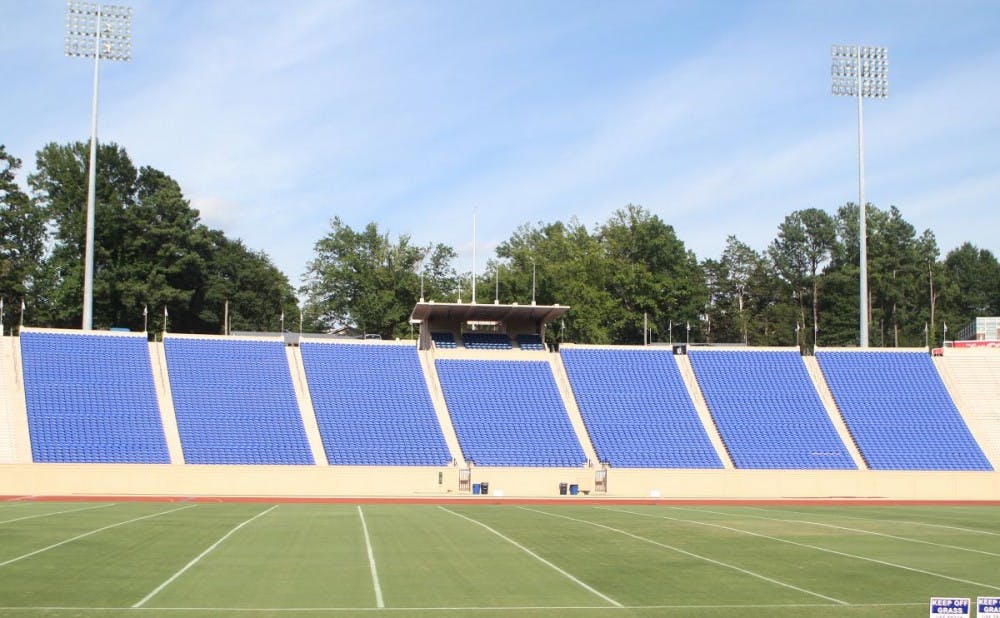Although a concussion class-action lawsuit was filed by a former football player against Duke, the ACC and NCAA Wednesday on behalf of all Blue Devil players from 1953 to 2010, experts question whether or not the players during the 58-year period will be certified as a class in court.
The law firm Edelson PC filed the lawsuit on behalf of Derrick Lee, a defensive back who played at Duke from 1998 to 2003. The Lee lawsuit is part of a group of 10 similar suits the firm has filed recently which allege that universities, athletic conferences and the NCAA knew about the risks of football-related head injuries and were negligent in handling such cases.
However, it could be challenging for the law firm to get the class of players certified in federal court because players during the 58 years competed in different eras and experienced varying coaching techniques, said Jay Trehy, Trinity '79 and a personal injury lawyer in North Carolina. Trehy also represented former men's lacrosse head coach Mike Pressler after the 2006 lacrosse case when Pressler sued Duke.
Trehy explained that because players at different positions could receive different numbers of head blows, individual circumstances could be more important than the similarities among members of the class.
"I'll be very surprised if the class is certified," Trehy said. "One motive for attempting a class, however, is to alert others that there may be a case... Strategically, this may be an effort to make others aware that this law firm believes they have evidence to show that these institutions that were benefiting off these athletes knew earlier than they admit to and should have done something earlier than they admit to."
Paul Haagen, professor of law at Duke, also noted in an email that establishing that the football players represent a class could be difficult but explained that the suit could still have a broader impact.
"This suit is part of a significant change in cultural and social understanding in sport and particularly football," Haagen wrote.
The reason the class in Lee's lawsuit—the initial filing for which can be viewed fully here—includes players from 1953 to 2010 is because the NCAA required schools to implement concussion management plans for all sports in April 2010, said Christopher Dore, a partner at Edelson PC.
The initial filing of the lawsuit cites research dating back to the 1920s about abnormal behavior found in boxers who had suffered significant head blows. The first football-related research noted in the filing is from the 1930s, when the American Football Coaches Association recommended that players who suffer concussions be removed from play.
A New England Journal of Medicine article from 1952 that recommended players stop playing football after receiving their third concussion is also cited as evidence in the filing.
Trehy—who played football in high school before switching to rugby in college after suffering a neck injury—noted that the different tackling styles taught throughout the years before concussions became a public issue could pose a challenge for the plaintiff.
"The techniques that were taught relied upon using the hard shell of a helmet and the strength of the neck to deliver blows," Trehy said. "My question is going to be, 'What did they know and when did they know it? At what point did Duke know enough that it needed to do something to protect its athletes? At what point did anyone know?'"
Trehy compared the class in the Lee lawsuit to a recent class-action lawsuit brought against large tobacco companies for misleading consumers. The class in that case was declassified because individual circumstances were deemed more important than the group's common traits and the parties eventually settled.
Although more knowledge about head injuries has been made pubic in recent years, Dore said that young athletes joining college football programs were not in a position to fully understand the risks of playing like universities, conferences and the NCAA were.
"They are not provided with the knowledge, the research and the access to information that something like the NCAA or a university has," Dore said. "The NCAA has been doing research for decades. They have access to all the schools and all the results of different injuries from different time periods and can see the big picture of what's happening."
Dore explained that the Lee case could take awhile, with the defendants now having the opportunity to respond, move to dismiss the lawsuit or answer before discovery takes place. He noted that if Lee and other former players cannot reach agreements with the NCAA, conferences and universities, the law firm is prepared to take the cases to trial.
"We are hopeful that the conferences and the schools and the NCAA decide to do the right thing and step up," Dore said. "The bottom line is that there are people that are suffering day to day and waiting several years for a case is just extending that pain and suffering for them."
Michael Schoenfeld, vice president for public affairs and government relations, declined to comment on the lawsuit Wednesday.
Amy Yakola, senior associate commissioner and chief of external affairs for the ACC, wrote in an email that the league does not comment about ongoing litigation.
Get The Chronicle straight to your inbox
Signup for our weekly newsletter. Cancel at any time.

